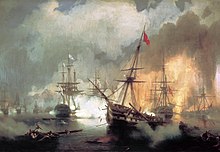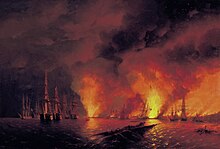Vladimir Alexeyevich Kornilov

Wladimir Alexejewitsch Kornilow ( Russian Владимир Алексеевич Корнилов , * February 1 July / February 13, 1806 greg. In Irkutsk ; † October 5 July / October 17, 1854 greg. In Fort Malakow , Sevastopol ) was a Russian vice-miral and head of the city the defense of Sevastopol during the Crimean War .
Life
Vladimir Alexeyevich Kornilov was born in a village not far from Irkutsk. His father, Alexei Michailowitsch Kornilow, was a naval officer with the rank of frigate captain , later held government offices in Siberian districts and at the end of his life became a senator of the Russian Empire . His mother, Alexandra Yefremovna, moved with her son to their native Ivanovsk estate in Tver Governorate after their father became governor of Tobolsk . Following in his father's footsteps, Kornilov studied at a cadet school from 1821 and was dismissed as an ensign after two years . Service in the coastal defense force of the Marine Guard was a nuisance to the gifted Kornilov. He could no longer stand the routine of parade parades and the drill and was discharged from the Alexander I fleet because of "insufficient courage to serve at the front".
Career

In 1827 he was allowed to return to the fleet at the request of his father. He first served on the newly built ship of the line Azov under Lazarev , which arrived directly from Arkhangelsk . As part of the Azov ship's crew , Ensign Kornilov experienced the difficult crossing from Kronstadt to the Mediterranean, where the ship became part of the united Russian-Anglo-French squadrons to support the rising Greece . Kornilov witnessed the battle of Navarino against the Turkish-Egyptian fleet on October 8, 1827 . Besides Kornilov, Lieutenant Nakhimov and Guards Marine Istomin fought there .
After the fighting ended, Kornilov returned to the Baltic States , but was summoned to Sevastopol by Lazarev, who had become chief of staff of the Black Sea Fleet and who remembered the brave officer well. During the Bosporus expedition in 1833, when Russia decided to promote the peaceful regulation of Egyptian-Turkish relations, Lazarev commissioned him with military reconnaissance of the Bosporus area . For his services to the successful completion of the expedition, Kornilov was awarded the Order of St. Vladimir of the fourth degree.
After his return to Sevastopol, Kornilov became the commander of the new brig Femistokl and drove to Constantinople and Piraeus and made a name for himself in the recall of the Russian ambassador from Turkey . From 1837 Kornilov commanded the corvette Orest and then the ship of the line Twelve Apostles equipped with 120 cannons . On these ships he perfected his skills in the art of ship and crew management and continued to train himself in matters of naval warfare.
In 1838 Kornilov, meanwhile with the rank of frigate captain, was appointed as chief of staff of the Black Sea Fleet, which was under Lasarev's command. Despite his young age, he became Lazarev's irreplaceable assistant in matters relating to the management of the Black Sea ports, the development of the fleet and the training of ship's crews. Promoted to sea captain in 1840 , Kornilov took part in various combat operations of the squadrons in the eastern Black Sea , such as the conquests of Tuapses and the fortress of Psesuap, which served to subdue the Caucasus .
In 1846 Kornilov was commanded to England to oversee the construction of steam warships for the Tsar's fleet in British shipyards. He advocated radical modernization and a fleet building program that was to replace sailing ships in the navy entirely with steamers. When he returned to Russia two years later, Kornilov was promoted to Rear Admiral and stayed with Lazarev on special assignments. He took over the duties of the Chief of Staff of the Black Sea Fleet again from 1849. As Kornilov was an authority not only in Sevastopol but also in Saint Petersburg , he was accepted into the retinue of Tsar Nicholas I and was directly subordinate to the Chief of the Naval Staff, Menshikov . In 1852 Kornilov was promoted to Vice Admiral and he was given the title of Adjudant General. In anticipation of the further deterioration of the situation on the south coast of Russia, Kornilov took energetic measures to build new ships in Nikolayev and had the docks and artillery arsenal in Sevastopol expanded.
Crimean War
Kornilov took part in Menshikov's unsuccessful mission to Constantinople, which aimed to provoke a war between Turkey and Russia. After Turkey declared war on October 16, 1853, Russia again declared war on Turkey on October 20. Thereupon the commander-in-chief of the sea and land forces of the Crimea sent Admiral Menshikov Kornilov with a group of ships to investigate the enemy, with the aim of "arresting and destroying Turkish warships wherever they were". Without discovering the enemy, Kornilov drove to the Bosporus and then sent two ships to reinforce the squadre to Nakhimov , who crossed the Anatolian coast and the remaining ships to Sevastopol. Kornilov boarded the steam frigate Vladimir and stayed on the Bosphorus. The first sea battle in history between steamships took place on November 5, 1853, when Kornilov met the Egyptian warship Pervas-Bahri , which was seized and maneuvered to Sevastopol . Soon after, he was commanded by Menshikov to the squadre of Nakhimov to take their lead.
Kornilov could not take part in the sea battle near Sinope on November 18, 1853 because he had taken up the pursuit of the Turkish steamer Taif in the Bay of Sinope. The defeat of Turkey in the naval battle, which ended with the annihilation of the Turkish fleet, caused England and France to enter the war. Kornilov was now responsible for the defense of the inadequately protected Sevastopol. Soon the Black Sea Fleet was trapped in the Sevastopol Bay by the Anglo-Franco-Turkish squadre. On September 11, 1854, all the sailing ships in the fleet were sunk in the bay to make it more difficult for the Alliance to attack the city by sea. The state of siege was declared on September 13th and Kornilov called on the inhabitants of Sevastopol to build the defenses. On October 5th, the city was massively bombed from the land and sea. While visiting the defenses at Fort Malakow, Kornilov was fatally wounded in the head that day. He was buried next to his teacher Admiral Lazarev in the Saint Vladimir Cathedral in Sevastopol.
literature
- VD Dozenko: Admirals of the Russian Fleet. Russia hoists the sails . Lenizdat, 1995, pp. 421-456
- NW Novikova, PG Sofgenova: Vice-Admiral Kornilov . Wojenizdat, 1947
- AP Shandr: Materials on the defense of Sevastopol and the biography of Vladimir Alexejewitsch Kornilov . 1859
- BI Swerev: Vice Admiral WA Kornilov . Krimizdat, 1957
- KW Lukashevich: Vice Admiral Kornilov. (Short biography) . Sytin Publishing House, 1915
- SN Sergejew – Zensky: Admiral WA Kornilov Historical summary.
- SN Sergejew – Zenskij: Stretching the Seas. Historical outline, stories, novellas, articles . Wojenizdat, 1985, pp. 103-108.
- EW Tarle: City of Russian Glory. Sevastopol in the years 1854–1855 . Wojenizdat, 1954
Web links
- The 100 greatest military leaders. Russian Military-Historical Society, accessed April 30, 2014 (in Russian).
Individual evidence
- ↑ The exact place of birth is unknown, according to recent research here. See: Александр Всеволодович Дулов: Где родился вице-адмирал В. А. Корнилов (1806–1854)? July 7, 2012, Retrieved April 30, 2014 (Russian).
- ↑ a b c d Vladimir Alexejewitsch Kornilow, Biographical Register. Retrieved April 28, 2010 (Russian).
- ↑ a b A singer and a vice admiral. Retrieved April 28, 2010 .
- ↑ Europe's first Verdun . In: Die Zeit , No. 33/2003
- ^ Karl Marx: The acts of war in the Orient - The Austrian and French finances - The fortification of Constantinople . In: Karl Marx - Friedrich Engels - Works . tape 10 . Dietz Verlag, Berlin 1961, p. 31–36 ( mlwerke.de [accessed April 30, 2010]).
| personal data | |
|---|---|
| SURNAME | Kornilov, Vladimir Alexejewitsch |
| ALTERNATIVE NAMES | Корнилов, Владимир Алексеевич (Russian) |
| BRIEF DESCRIPTION | Russian vice admiral and hero of the Crimean War |
| DATE OF BIRTH | February 13, 1806 |
| PLACE OF BIRTH | Irkutsk |
| DATE OF DEATH | October 17, 1854 |
| Place of death | Fort Malakov |
